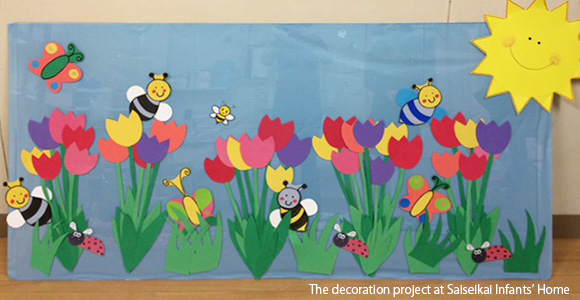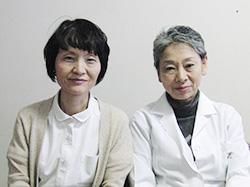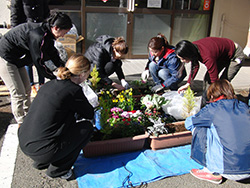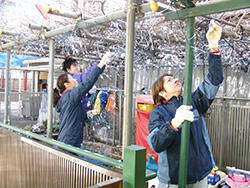クローズアップ パートナー
東京都済生会中央病院附属乳児院
このコーナーではハンズオン東京のパートナー団体の皆さんにスポットをあてます。今回紹介するのは、東京都済生会中央病院附属乳児院です。ハンズオン東京は、この乳児院で「Hug a Baby」という、子どもたちを抱っこするプロジェクトのほか、ガーデニング、イベントの飾り付けや運営のお手伝い、バスハイクなどを開催しています(「Hug a Baby」では、現在ボランティアの募集は行っていません)。乳児院は、どんなところなのか、ボランティアは何をお手伝いできるのか、乳児院院長、済生会中央病院小児科医師の韮澤眞理先生と、竹内まつ江看護師長にお話しを伺いました(*この記事は2015年のニュースレターより抜粋いたしました)。
竹内まつ江看護師長(左)と韮澤眞理先生(右)
乳児院というのはどのような施設なのでしょうか。
韮澤先生「社会的養護が必要な3歳未満の乳児をお預かりして養育する施設が乳児院です。全国で132カ所、東京都には10カ所乳児院があります。それぞれ規模は違いますが、私たちの乳児院では35人の子どもたちが生活しています」
子どもたちは、どのような理由で乳児院に来るのでしょうか。
韮澤先生「7割、8割の子どもたちは虐待が関係しています。暴力のほか、ネグレクトといって、お母さんがお世話をしない。乳児なのにちゃんとした離乳食を与えずに、お菓子で育てる。また、胎児虐待といって、妊娠していても産婦人科などで検診を受けずに子どもを産んでしまうということも含まれます。あとは、お母さんが病気で育てられないために預けられることもあります。ほかには、いわゆる捨て子や親が刑務所に行ってしまった子など、理由はさまざまです」
乳児院でのおもな仕事はどんなことですか?
韮澤先生「子どもを預かり、育てる、というのがメインの仕事です。子どもは3歳までしか乳児院にいられないので、そのあとは児童養護施設に行くのか、お家に帰るのか、里親さんのところに行くのか、という自立支援計画を、児童相談所と一緒に考えます。子どもを家庭復帰させるために、親御さんと何度も面談をしたり、または里親さんを捜したりということも仕事のうちのひとつです」
私たちボランティアは、何をお手伝いできるのでしょうか。
竹内看護師長「現在、庭の手入れ、ガーデニングやお掃除など、保育士である私たち職員が、なかなか手の届かないところをやって下さっていて、本当に感謝しています。ハンズオン東京の皆さんに協力していただいてから今年で5年目になりますが、『何か手伝わせて下さい』とハンズオン東京のスタッフのかたが訪問してくださったのが、きっかけでした。そこから『次は?』『次は?』というかたちで広がっていきました。『Hug a Baby』の活動(子どもたちを抱っこする活動)も、どんどん広がりました。また、バスハイクも、ハンズオン東京の皆さんにお願いして、3年前から開催していただいており、とても頼もしく思っています」
ほかにお手伝いすることはないですか?
竹内看護師長「そうですね……繕い物でしょうか。乳児院では洗濯を全部マシンでやっていて、乾かすのも乾燥機なので、ボタンが取れやすく、衣類が傷みやすいんです。今はおばあちゃまたちのボランティアさん4名に来ていただいていますが、もう少し人数が集まるといいですね」
韮澤先生「おばあちゃまたちは、みなさん70歳過ぎのかたたちで、繕い物だけでなく、おもちゃのカバーを作ってほしいとリクエストすると、とてもかわいいのを作ってくれるんです。ですので、一緒にソーイングをしてくださる、クラフトなどが趣味のかたが来て下さったらうれしいです」
ハンズオン東京のボランティアさんたちにひとことお願いします。
竹内看護師長「日本ではボランティアをするという意識がまだまだ少ないと感じますが、ハンズオン東京のボランティアさんは海外で生活していたかたも多く、その意識が高いように思います。ガーデニングやおそうじなど、直接子どもと接する場面が少ない活動では、日本語を話さなくても大丈夫ですので、ぜひ、いらしてください」
◆「子どもたちはみんなかわいいです」と優しい笑顔でお話しくださった韮澤先生と竹内看護師長。5年前、ハンズオン東京のスタッフが「何か手伝わせて下さい」と乳児院を訪ねたことから始まった私たちのリレーションシップが、これからも長く、深く続きますように。
(*この記事は2015年のニュースレターより抜粋いたしました)



